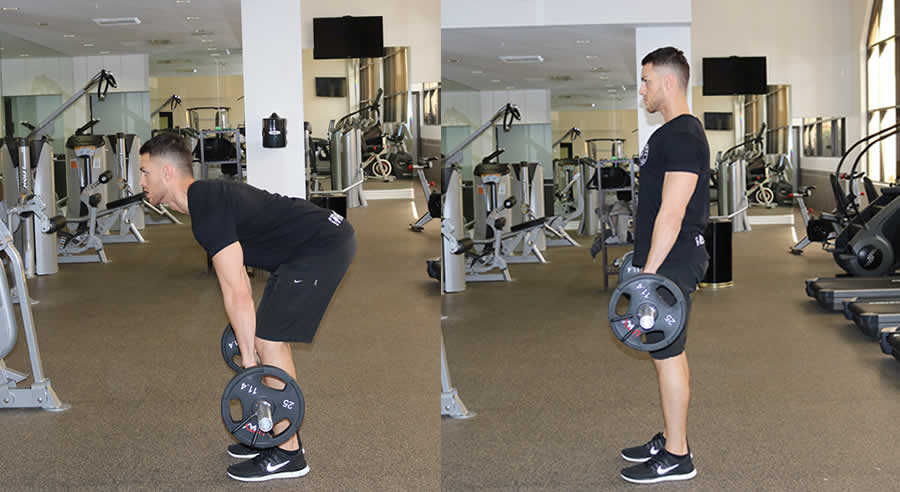Purpose of the Stiff Leg Deadlifts
The stiff leg deadlift is designed to target the muscles on the backside of the body, starting primarily at the lower back, and running all the way down the back of the thigh to the back of the knee. Because the hamstrings pass through both the knee joint, and hip joint, they are generally the primary muscles you would be wanting to target when selecting this exercise.
Equipment Needed for Stiff Leg Deadlifts
The stiff leg deadlift is traditionally performed with a barbell, although dumbbells offer a good substitute. The major difference between the two has to do with the center of gravity – with a bar it will be slightly in front of the body, while dumbbells allow you to better keep the center of gravity over your base of support.
Difficulty of Stiff Leg Deadlifts
On a scale of 1 to 5, the stiff legged deadlift would be around a 2 as it is primarily a single joint movement (the hip being the primary joint in movement, although the spine and/or knee may want to be mobile, the goal is to prevent that from happening).
How to Perform Stiff Leg Deadlifts
To perform a stiff legged deadlift, assume a shoulder width stance, with a barbell in hand – grip should also be shoulder width. Initiate the descent by slowly bending at the hips only – a slight knee bend is acceptable if your flexibility does not permit. Lower as far as you can while maintaining proper mechanics (this means not allowing the spine to round) – some people may be able to achieve greater depth than others. Pause at the bottom of the range of motion before lifting controllably back to the starting position.
Key Points for Stiff Leg Deadlifts
- Use a shoulder width stance, and a shoulder width grip
- Bend at the hips only – slight knee bend is permissible for those who lack flexibility in the hamstrings
- Lower as far as your body will allow while maintaining proper mechanics, and keeping the tension on the hamstrings
How Many Reps when Performing Stiff Leg Deadlifts
The stiff leg deadlift is an exercise that can be done for both low reps, and high reps, depending on the goal. It’s a compound movement ideal for lifting greater loads, but also comes with its risks, as it can place a lot of stress onto the lower back. It’s for this reason that the suggested amount of reps is at least 8, and once you have the hang of it you can make the conscious decision to add weight and decrease reps at your own discretion.
Common Mistakes when Performing Stiff Leg Deadlifts
Some of the more common mistakes when performing stiff legged deadlifts are:
- Rounding of the back – descending by bending at the spine instead of the hips. This is a big no-no, and is a surefire way to welcome unwanted injuries. Also, make sure to maintain a neutral spine – if you can’t, you should look for an alternative exercise to target the desired muscle groups.
- Bending at the knee – this turns the movement into a traditional deadlift, which is a great exercise if you want to do it, but defeats the purpose of attempting to do a stiff-leg deadlift in the first place.
- Using too much weight – this often forces the back to round and results in poor form.
- Locking the knees – this is very dangerous as it puts the knees in a vulnerable position.
Modifications to Stiff Leg Deadlifts
There are two ways to modify a stiff leg deadlift without turning it into another exercise. You can widen, or narrow, both the stance, and the grip.
A wider stance decreases the range of motion, while a wider grip increases the potential range of motion (“potential,” because it allows you to go lower only if you choose to).
When to Perform Stiff Leg Deadlifts
Stiff leg deadlifts can be used at both the beginning, and end of a workout. They are ideal for the purpose of recruiting lots of muscle fibers, or fatiguing lots of muscle fibers. If there was a caveat, it would be not to do them too early in a workout if you intend to do other exercises like squats, as they may fatigue the lower back to the point where it negatively affects your squats.
Alternatives to Stiff Leg Deadlifts
The obvious alternative to a stiff legged deadlift would be a traditional (bent-knee) deadlift. The bending of the knee reduces the demand placed on the hamstrings, and may be more ideal for those training for strength, or those who lack flexibility.
Another alternative for those looking to target the same musculature, without placing nearly as much demand on the lower back, would be cable pull-throughs. To perform this exercise you need a cable apparatus with a low attachment, and a rope attachment. Begin by holding the rope between your legs, facing away from the cable apparatus, and standing a couple feet in front of the cable stack. Bend at the hips to allow the rope to pull closer to the cable stack, but don’t let the weight rest. Pause at the end of the range of motion before contracting the glutes, and hamstrings, to initiate extension of the hips, and be sure to squeeze those same muscles hard at the end of the concentric range of motion.
Stiff Leg Deadlifts vs. Deadlifts
While both variations are considered deadlifts, the bending of the knee, or lack thereof, effects the recruitment of the involved musculature. When the knees are kept extended, the demand placed on the hamstrings is magnified in comparison to when the knees are allowed to bend. Bending of the knee also brings the quads into the movement, and is a big part in why most people can deadlift more with a bent-knee.



